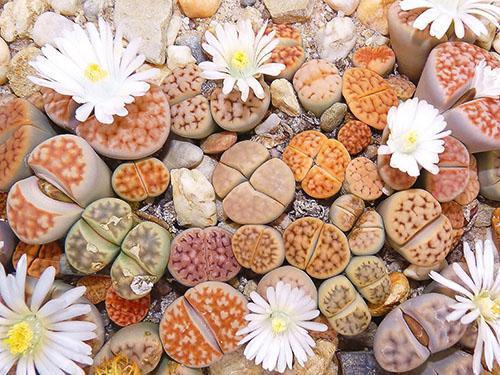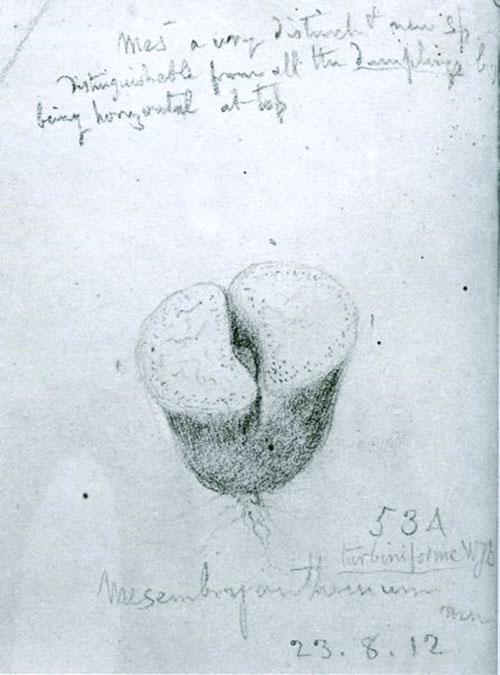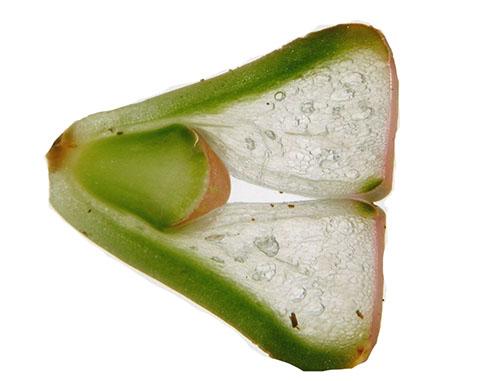Care and maintenance of "living stones" of lithops at home
 The discovery of these amazing plants belongs to William Burchell, an English botanist and naturalist who traveled in September 1811 in the desert in the South African region of Prisca. In a book published later, the scientist gave a drawing of the discovered plant. Notice between the stones that look like round pebbles lithops the traveler was helped by a fluke, so good was the disguise.
The discovery of these amazing plants belongs to William Burchell, an English botanist and naturalist who traveled in September 1811 in the desert in the South African region of Prisca. In a book published later, the scientist gave a drawing of the discovered plant. Notice between the stones that look like round pebbles lithops the traveler was helped by a fluke, so good was the disguise.

Lithops - living stones of the desert
Lithops managed to hide from the close attention of botanists for about a hundred years, because their current name, derived from "lithos" - stone and "opsis" - look, the plants received only in 1922. Today, six dozen species have been discovered and described, outwardly, indeed, resembling stones of all kinds of plant colors, opening yellowish or white flowers in autumn.
 But the "stone" look of lithops is deceiving.
But the "stone" look of lithops is deceiving.
Two thick, intergrown leaves, of which the aerial part consists, are literally filled with moisture.
This is a kind of reservoir where the plant stores the water supply that is so necessary in the desert, providing growth, bud development, flowering and reproduction of lithops. The dimensions of the amazing "living stone" are modest, most species barely reach 5 cm in diameter. The leaves are attached to an inconspicuous, short stem, and the plant feeds on a long taproot. Nevertheless, at home, lithops are grown from seeds, and the grown "pebbles" delight the owners for many years.
 To make pets feel comfortable in an apartment, it is important to provide proper care. Otherwise, it is difficult to wait for the flowering of "living stones", and sometimes the plants die altogether.
To make pets feel comfortable in an apartment, it is important to provide proper care. Otherwise, it is difficult to wait for the flowering of "living stones", and sometimes the plants die altogether.
Lithops care at home
 If the care and maintenance of lithops is to their liking, they bloom regularly, their leaves are elastic and change to new ones about once a year. When the plant receives enough light, water and nutrition, it sits tightly on the soil and consists of a pair of leaves. As they grow, they begin to "lose weight" and dry out, and a new pair begins to appear through the gap.
If the care and maintenance of lithops is to their liking, they bloom regularly, their leaves are elastic and change to new ones about once a year. When the plant receives enough light, water and nutrition, it sits tightly on the soil and consists of a pair of leaves. As they grow, they begin to "lose weight" and dry out, and a new pair begins to appear through the gap.
As a native of the desert, lithops need year-round lighting. At home, it is better to place pots with these plants on the southern windows, but if this is not possible, lithops can be grown at home only in a greenhouse with constant artificial lighting.
 Summer temperatures prevailing in the middle lane, of the order of 20-24 ° C, are quite acceptable for guests from South Africa, because they perfectly tolerate the forty-degree heat. The main thing is that the pets forced to experience high temperatures do not additionally fall under direct sunlight. At home, lithops with especially hot periods fall from a semblance of hibernation, restoring vital processes only at night, when the desert cools down. How to grow lithops in an apartment?
Summer temperatures prevailing in the middle lane, of the order of 20-24 ° C, are quite acceptable for guests from South Africa, because they perfectly tolerate the forty-degree heat. The main thing is that the pets forced to experience high temperatures do not additionally fall under direct sunlight. At home, lithops with especially hot periods fall from a semblance of hibernation, restoring vital processes only at night, when the desert cools down. How to grow lithops in an apartment?
In the warm season, lithops can be taken out into the garden or on the balcony, not forgetting to protect the pots from the sun. During the hottest months, the pots are shaded by 20-30% during the daytime. The rest of the time, sun protection is needed only when the rays are directly hitting the plants. In winter, a hibernation period begins for plants. At this time, a comfortable temperature will be about 10–12 ° С, but not lower than –8 ° С, otherwise the liquid inside the thickened leaves begins to freeze and destroy cells.
 Caring for lithops at home is not complete without transplanting grown plants. When the root system of the lithops fills its allotted volume, the plant is transplanted, choosing wide pots for this culture, slightly deeper than the length of the main root of the flower. Since lithops does not tolerate stagnant moisture, a drainage layer must be made at the bottom, and after transplanting the plant, greenhouse conditions are created for 2–6 weeks, carefully monitoring the soil moisture, the absence of drafts and the lighting regime.
Caring for lithops at home is not complete without transplanting grown plants. When the root system of the lithops fills its allotted volume, the plant is transplanted, choosing wide pots for this culture, slightly deeper than the length of the main root of the flower. Since lithops does not tolerate stagnant moisture, a drainage layer must be made at the bottom, and after transplanting the plant, greenhouse conditions are created for 2–6 weeks, carefully monitoring the soil moisture, the absence of drafts and the lighting regime.
If lithops are very sensitive to a lack or excess of moisture, then the composition of the soil for them can be practically any. It is only important that the substrate can retain the amount of water required by the plant, and is moderately nutritious.
The approximate soil composition for this species may include:
- two pieces of leafy land;
- part of the clay;
- two parts of washed sand;
- a small amount of peat.
 After planting lithops, the soil surface is sprinkled with small pebbles, crushed shells or other mulching agent that prevents moisture evaporation and the development of mosses and molds on the soil. Lithops can be fed once every two years, if the plant has not been transplanted into new soil during this period. In this regard, care, like the maintenance of lithops, is not burdensome and simple.
After planting lithops, the soil surface is sprinkled with small pebbles, crushed shells or other mulching agent that prevents moisture evaporation and the development of mosses and molds on the soil. Lithops can be fed once every two years, if the plant has not been transplanted into new soil during this period. In this regard, care, like the maintenance of lithops, is not burdensome and simple.
Features of watering lithops
 If, with a lack of moisture, lithops can live for some time due to the supply in the leaves, then excessive watering, and especially stagnant water, quickly leads to decay of the root system.
If, with a lack of moisture, lithops can live for some time due to the supply in the leaves, then excessive watering, and especially stagnant water, quickly leads to decay of the root system.
In order for the plant to constantly feel comfortable, it is necessary to choose the right irrigation regime and be very attentive to the state of the "living stone". This is the main part of lithops home care:
- When lithops changes old leaves for new ones or picks up buds, it needs the most abundant watering.
- But in winter, with the onset of a dormant period, the soil is only occasionally moistened or watering is stopped altogether.
 From mid-April to December, lithops can be watered after 10 days, but the plant itself can tell when it lacks moisture. This signal will be wrinkling of leaves in the daytime, which persists the next morning. On especially hot days, the maintenance and care of lithops becomes more difficult. Plants are given an evening shower, sprinkled with warm water.
From mid-April to December, lithops can be watered after 10 days, but the plant itself can tell when it lacks moisture. This signal will be wrinkling of leaves in the daytime, which persists the next morning. On especially hot days, the maintenance and care of lithops becomes more difficult. Plants are given an evening shower, sprinkled with warm water.
With the beginning of wintering, watering is stopped. It needs to be renewed in February, at which time plants can receive water once every three weeks or a little more often if the process of opening the gap between the old leaves is too delayed.
When watering, it is important to prevent moisture from entering the gap between the leaves, and so that the drops remain on the sides of the lithops. This can cause sunburn or tissue rot. If the regular watering is moderate, the soil in the pot is soaked well once a month, which mimics the rainy season and serves to develop the root system. It is watering, the most important part of lithops care at home, that determines the vitality of old leaves and the appearance of lithops. If the plant receives a lot of water, its excess accumulates in the aerial part, as a result, leaves that have outlived their life do not die off and spoil the appearance of the plant.
Growing lithops from seeds at home
 If you want to get young lithops from seeds, it is better to sow at home in March.
If you want to get young lithops from seeds, it is better to sow at home in March.
Before growing lithops, a substrate is prepared based on:
- one part of red brick crushed to 2 mm;
- two parts of sod land;
- two pieces of sand;
- one part of clay and the same amount of peat.
Then the soil is steamed, mixed, cooled and loosened again. When filling the pot at 25-30% of the height, a drainage layer is made of fine gravel, and then the soil is covered and moistened.
Seeds are soaked for the fastest hatching for 6 hours and, without drying, are sown on the surface of the prepared soil.
Now the development of young lithops at home depends only on caring for them.After sowing, the container is covered with glass or foil and placed for germination in a warm, lighted place.
In order for the seeds to sprout better, it is better to immediately provide conditions close to natural:
- During the day in the greenhouse or in the area of the container it should be 28-30 ° С, and at night only 15-18 ° С.
- Once or twice a day, the film is removed and the crops are aired for a couple of minutes.
- When the soil dries up, it is moistened with a spray bottle.
 After 6-12 days, you should wait for the first shoots and prepare for a new phase of caring for lithops at home. When tiny sprouts appear above the ground, you need to ventilate them up to 4 times a day, gradually increasing the procedure time to 20 minutes. It is important that the air in the greenhouse does not warm up above 40 ° C, and the direct rays of the sun do not fall on the seedlings. If there is not enough light, after a few days the plants will signal a faded color.
After 6-12 days, you should wait for the first shoots and prepare for a new phase of caring for lithops at home. When tiny sprouts appear above the ground, you need to ventilate them up to 4 times a day, gradually increasing the procedure time to 20 minutes. It is important that the air in the greenhouse does not warm up above 40 ° C, and the direct rays of the sun do not fall on the seedlings. If there is not enough light, after a few days the plants will signal a faded color.
When the size of young lithops is equal to a pea, the surface of the soil in the pot is carefully mulched with small stones. And at the first traces of mold or moss on the soil, they are treated with a solution of potassium permanganate.
Despite the difference in the growth rate of home-grown species of lithops, six months after sowing, it is time for the first change of leaves. This means that watering is limited to plants, which is resumed only after the old leaves are completely dry. If small lithops develop better when there is some distance between them, then adult "living stones" are planted close to each other, leaving gaps of no more than 2-3 cm. The first transplant of seedlings can be carried out a year after planting, into a substrate for adult lithops. maintenance and care of which is not so difficult.
Thank you so much for the article!
I want to do lithops, but the first experience of buying seeds turned out to be unsuccessful - nothing came up, although I followed the instructions. Could you sell me seeds or recommend a good seller who can do shipment outside Russia? Thank you so much.
Unfortunately we do not sell seeds. You can find a seller by visiting the gardening forums. The second option for acquiring lithops can be to search for like-minded people in your city. Visit exhibitions of indoor plants and you may be lucky.
Vera, hello! Yesterday I went to a flower shop in our city (Chita) - there are lithops for sale, but the choice is small. There is also a good selection of lithops seeds in online stores (price from 35 to 75 rubles), they are sent by mail, because the weight is small, then delivery in Russia will cost you from (180 - 250 rubles). Try to order. Then write here, you will help our other readers.
There is also a lithops seed on aliexpress.com - here the price starts from 25 rubles, but keep in mind that the parcel will go for at least 2 weeks (although it reached me in 1 week), but do not pay for the shipment. The quality of their seeds is unknown, but people order rose seeds and there are shoots. For this price, I think it is worth ordering a few bags to sample. And we will be grateful if you share your experience here.
I hope I helped. We are waiting for the result from you. All the best!
PS: after looking at the lithops, I also decided to order myself, then I will unsubscribe. 😉
Never buy seeds on aliexpress.com! Only money down the drain, ordinary grass rises! I ordered seeds by mail, they sprout well only they grow for a long time. You can, of course, order a grown plant, but it will come out more expensive and not the fact that it will take root normally. I can advise the seeds of the "cactus club", I ordered the seeds there, I was satisfied
I support you 90%. Ordering seeds on ali is a big risk. 99% of sellers expel weeds at best. But the last time I was lucky - I got exactly what I ordered (lithops, echeveria, lavender). The seeds sprouted - everything turned out to be exactly what was needed. My advice is to read the reviews carefully and order only where others have already confirmed that what is needed is growing.
Please tell me, can you plant lithops seeds in autumn?
Spring cultivation of indoor plants from seeds, including lithops, is practiced for the reason that at this time the daylight hours are quite long. Sown lithops, like other flowers, need good lighting, otherwise they will lose their rich color and grow faded. However, if you have the opportunity to install additional lighting, it is quite possible to try sowing Lithops seeds in the fall.
Hello, my lithops are half a year old, they are very small 5 millimeters, What size should they be at this age?
I do not know how to water them everywhere they write differently. And some of them have already shed. Some wrinkled. I can say I don't water them at all. Please explain how to take care of them so that they grow up.
Thank.